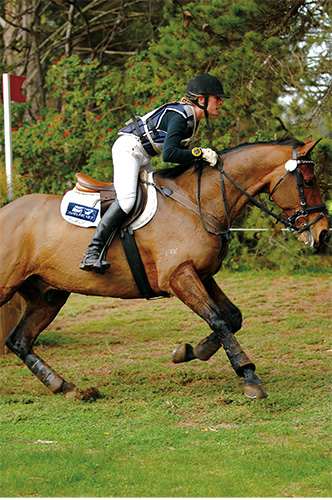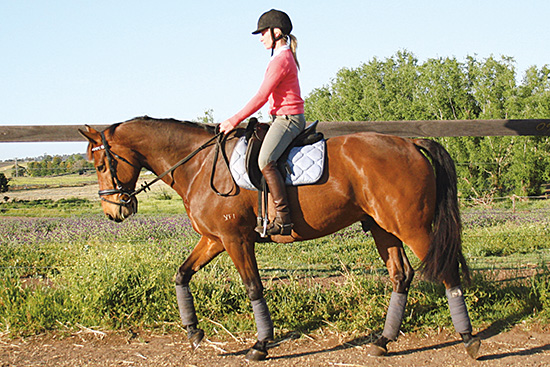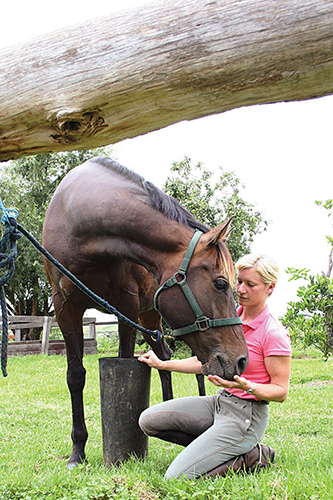 How to… Make – but not break – a cross country horse
How to… Make – but not break – a cross country horse
Story by Emma Mason and Photos by Ann-Maree Lourey and Roz Neave
A fit, sound horse is critical in the sport of eventing, especially when it comes to the cross-country phase of a Three Day Event. This month’s lesson will focus on managing the horse’s fitness and wellbeing throughout your preparation for a three day event, and in keeping with the Aussie flavour of the series, will pay particular attention to hard ground, hot weather and other uniquely Australian conditions!
The Fitness Program
Just like people, horses come in all shapes and sizes (and attitudes toward exercise!), so I try to work out a fitness regime that best suits each individual horse. The ex-racehorse seems to be blessed (cursed?) with a remarkable level of natural fitness (hence the problems we can sometimes run into in the dressage phase, as discussed last month!), and is usually quite happy travelling at faster speeds. For these reasons, the Thoroughbred may not need the same type or amount of work as, say, a Warmblood.
For example, leading up to Melbourne Three Day Event in 2007, I had two horses to prepare: Angelina Ballerina, a Thoroughbred mare in the 1-star class, and Farinelli, a Warmblood/TB gelding entered in the 2-star. The level at which they were competing was definitely a factor, as the 1-star horses aren’t required to travel as far, or as fast, as the higher grades. But I also had to consider the marked differences between them: Angelina is like, well, a ballerina – really athletic, nimble and quick on her feet. Galloping across country at the One Day Events leading up to Melbourne, plus schooling this phase at home, was enough to see her cruise around the Three Day course and barely raise a sweat. Farinelli, on the other hand, is naturally a bit heavier and not quite as fast, so it was necessary to begin his gallop work some 8 -10 weeks before the big event.
Additionally, the age of the horse should be considered – the older horse may take a little longer to ‘bounce back’ after a strenuous workout. Also of relevance is whether the horse has undertaken a 3DE preparation in the past, as this horse will often need less work to reach the desired level of fitness than one starting from scratch.
Gallop work?
The term ‘gallop’ is traditionally used for these fitness sessions, but for the most part, I’m really referring to more of an ‘open’ canter. I like to schedule a gallop session once every four days, and I try to make the day after a gallop a little less strenuous. For instance, I might work the horse on the flat, keeping my eye out for signs of fatigue or soreness, and then walk him in an attempt to ease any stiffness. I avoid jumping the day after a gallop session.
It is likely that you’ll be competing in One Day Events in the weeks leading up to a Three Day Event, so you may have to adjust your horse’s fitness program slightly to allow for the cross country phase of these events: Running the horse around the cross country is counted as a gallop session, and as this usually falls on a Sunday, you’d ideally like to gallop him about Wednesday of the week prior.
The actual content of the session really does depend on the individual horse, but as a general rule, I’ll walk for about 10 minutes and trot for five as a warm up, and then the actual workout is made up of three sets of gallop with a three minute walk in between. To warm down, I’ll trot for a few minutes and then walk until he’s stopped puffing and his breathing starts to return to normal. I try to use these gallops as an opportunity to get the horse soft and round at this pace, rather than letting him coast around like a llama: After all, a horse that is easily adjustable in front of the fences is much more likely to make the time allowed than the fast horse who fights his rider the whole way around.
If I’m riding a horse that copes well with the faster work, I might use these sessions for conditioning more than anything else. In this case, the set might be longer, perhaps eight minutes, but at a reasonably steady pace, and this has the advantage of putting less strain on the horse’s legs.
Until you’re used to it, riding in your 2-point, light seat for this amount of time will probably have your legs and back screaming in protest, but it’s important to keep up off your horse’s back! I’d then use cross country training sessions to school short bouts of the fast work, usually by having a gallop between fences and then working on having the horse listen and come back to me before the jump.
For horses like Farinelli, I want to introduce a faster pace into the gallop sets. I might begin this type of program with five minute sets, and increase the time gradually. We’re fortunate at Lochinvar to have a gallop track that incorporates a nice, steady climb up a gentle hill, and it is here that I’ll open the horse up to a gallop.
This has the benefit of accommodating the fast work, but with a little less strain on the forelegs (travelling at speed on a surface that slopes even slightly downward is risky, as it puts a lot of pressure on the horse’s front end). I usually don’t sprint the horse in the third set, as he will be growing quite tired, and again, the risk of injury increases.
The gallop surface
The surface upon which you gallop your horse can play a big part in keeping him sound, and in Australia, where we’re so often in need of rain, this can present difficulties. If the ground is hard where you ride, be prepared to travel him to a more suitable venue for his gallop work: The firm sand at the beach is ideal, as it provides just enough ‘give’, and is nice and level. Also, walking him in the shallow water is an excellent natural means of cooling and soothing his legs. Obviously, however, not everyone is lucky enough to have an ocean around the corner, and even then, many beaches do not permit horse riding (and have signs every couple of metres, making it difficult to pretend that you didn’t know!). It may be a matter of asking around – your coach or other riders will often know of a suitable place in your area.
Ice
To help lessen the potential damage to your horse’s legs that galloping on hard ground – indeed, galloping at all – can cause, it is recommended that you get into the habit of icing him. This is crucial following the cross country phase at an event, not only to prevent damage, but also to make him feel as comfortable as possible going into the showjumping.
There are a few different styles of ice boot available, but my favourite is the “Big Foot” boot, as it targets a huge area, from the hoof right up to above the knee. I fill them about 1/3 of the way up with water, then put the horse’s leg into the boot (making sure his foot is standing flat on the ground) and then slowly fill the rest with ice. The drawback with these is that unless you have a horse that’s virtually comatose, you’ll have to sit with him while he does his time in the boots.
Another style out there is the boot with several pockets on the inside which are filled with ice, then secured on the horse’s leg via Velcro tabs. The advantage of this boot is that you won’t have to constantly monitor the horse, although the boots will need to be tightened from time to time, as the ice melts.
At a Three Day Event in particular, the horse has travelled a greater distance and is required to be sound at the Horse Inspection the next morning, so you may have to apply ice on and off right up until the stables are closed (at about 11 pm) and then again when they re-open. That’s where a groom or a parent/friend can definitely come in handy!
Riders often differ in their opinions as to the time intervals at which ice should be applied following the cross country phase of a 3DE. I’ve come across some who prefer 20 minutes on / 20 minutes off, but others who will stand the horse in ice for 3 hours non-stop. I’ll usually put my protesting horse in the Big Foot boots for about 45 minutes, with a 15-20 minute break. The number of times I repeat this depends on whether he sustained any knocks or bumps whilst on course, or if there’s any obvious discomfort or signs of soreness. After a gallop session at home, 30 – 40 minutes in ice should minimise any damage, and if you can’t access ice, even letting the cool water from the hose trickle over his legs for a while will help.
The heat
While there’s a lot to love about Australian summers, the effect of the hot weather on your horse’s performance and recovery is a factor that needs your attention when embarking on a fitness program. Galloping a horse during the hotter months of the year is akin to us going for a run in the middle of the day in summer – we feel tired much more quickly, and it takes longer for our body to cool down (and for our face to lose its bright red tinge). You’ll hear people talk about the importance of the horse being accustomed to galloping in similar conditions to those he’ll face on cross country day, and there’s a lot of logic in that argument. But I also think it has the most relevance in situations such as the Sydney Olympics, where horses were travelling from cold Northern Hemisphere climates to a city that can register pretty warm days in September. Perhaps not everywhere in Oz, but certainly where I am in the Hunter Valley, early mornings and late evenings are hot enough to familiarise the horse with performing in these conditions, but not so sweltering as to risk his well-being, so this is when I’ll carry out gallop sessions.
The treating veterinarians at a Three Day Event always stress the importance of cooling the horse quickly after he finishes the cross country, and their advice should also be followed after working him in hot temperatures at home. The procedure of hosing and scraping down will need to be repeated until the water you are scraping off is cool, rather than hot – this indicates that the horse’s temperature has come back down to a safe level. It is a common mistake to not scrape the excess water off the horse when he’s really warm, with the intention that this will help cool him down: In fact, this excess water quickly heats up and actually hinders the cooling process.
Hand-in-hand with the warmer Aussie climate is the fact that our horses will sweat, sometimes quite profusely, after a workout. Therefore, it’s a good idea to supplement their feed with electrolytes, to replace the salts they’ve lost. These can usually be purchased from your local produce or saddler, and while they’re not cheap, they do last quite a while (just beware of mixing them into the feed with your bare hands if you’ve got any cuts or scratches…Ouch!)
Long-distance travel
Although travelling for 15 hours in Europe will probably mean that you’ve passed through four different countries, in Australia it may be necessary to drive that distance to a 3DE (or further – I’m thinking Lochinvar to Adelaide and the endless hay plains in between). There are no tricks to travelling horses – you just need to make sure there is plenty of ventilation, and avoid the horse becoming overheated.
Unless it’s really quite cold, I tend not to travel them in rugs – remember that the horses next to them generate a lot of body heat. Particularly in the warmer months, driving through the night or in the early hours of the morning can help prevent them from becoming too hot. If your event does require you to travel a long distance, try to arrive at the venue as early as possible: Not only will this give you an extra day/s to familiarise the horse with the new surroundings, it allows him more time to recover from the journey, so that he can perform at his best.
I hope this article hasn’t made it sound like getting an event horse fit – without injuring him – is a difficult, daunting mission! Once you and your horse have a few events under your belt (girth?), many of the above suggestions will become second-nature. And while I won’t deny that it’s a bit stressful at the time, being paranoid about the soundness of your equine friend when preparing him for the rigours of a 3DE will be rewarded when he gallops triumphantly through those cross country finish flags…AND looks and feels a million dollars for the showjumping the next day.


